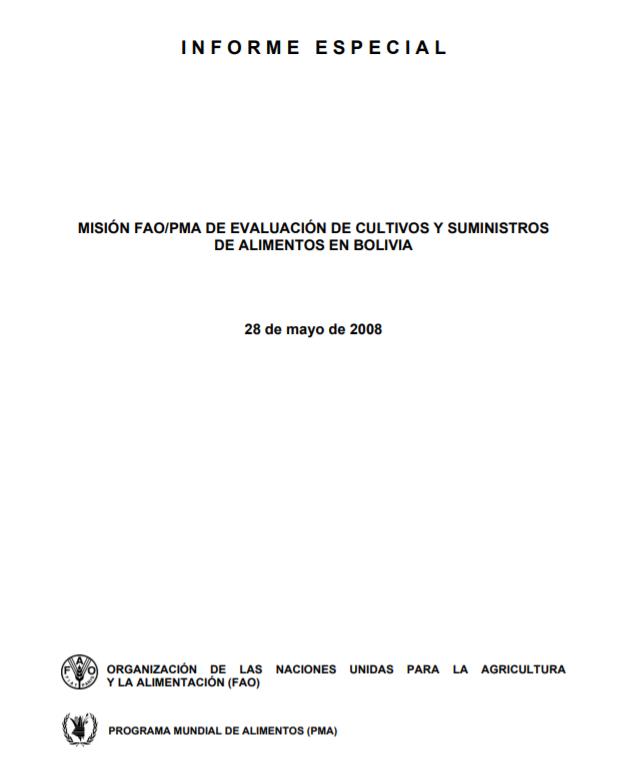
Informe Especial - Misión FAO/PMA de Eevaluación de Cultivos y Suministros de Alimentos en Bolivia
28/05/2008
Una Misión conjunta FAO/PMA de evaluación de los cultivos y suministro de alimentos visitó Bolivia del 4 al 18 de abril de 2008 a fin de evaluar la producción de cereales y tubérculos de 2008, que fue severamente afectada por una serie de eventos climáticos adversos tales como sequías, heladas e inundaciones, y estimar las necesidades de importación para la campaña comercial 2008/09 (julio/junio).
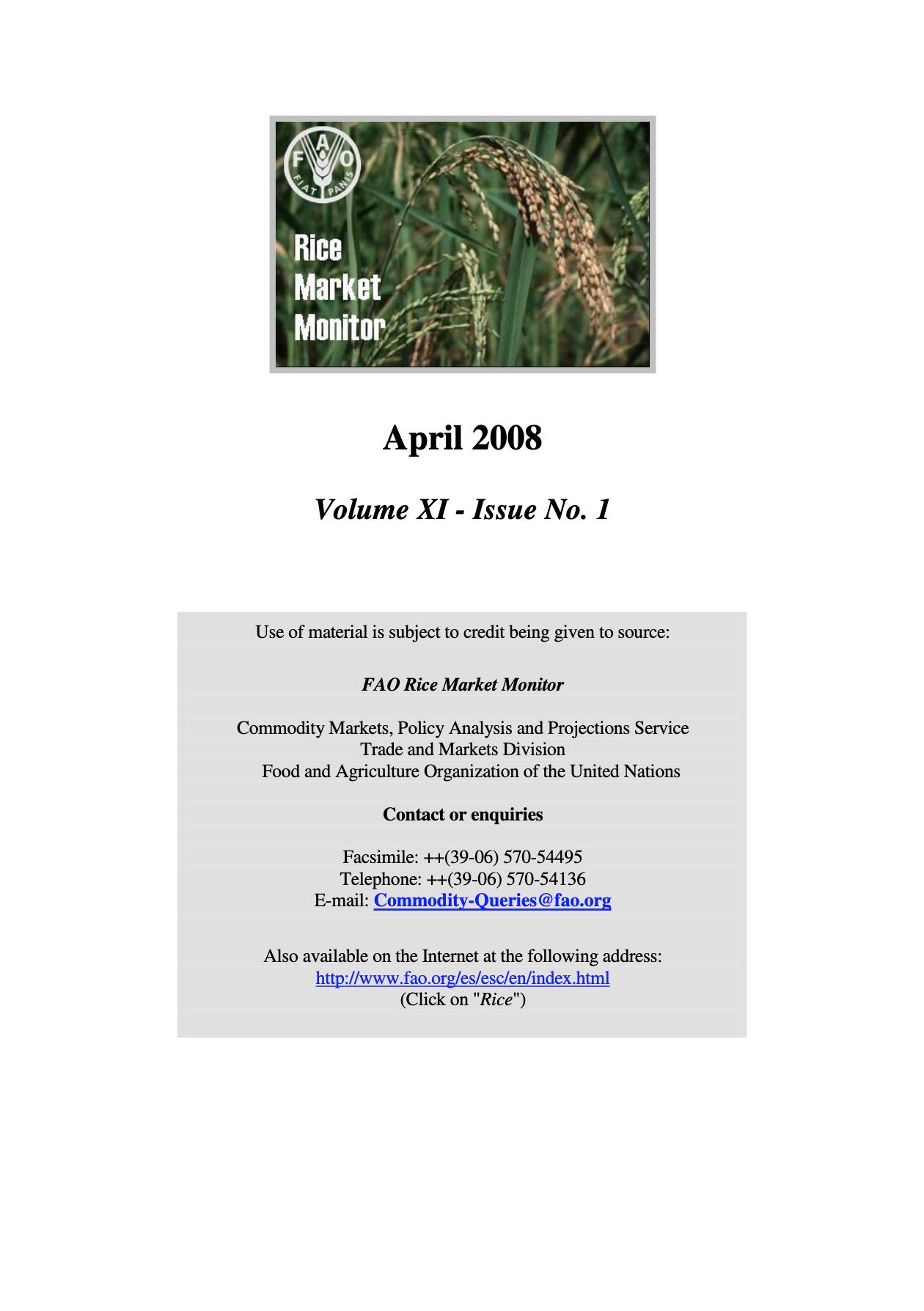
Rice Market Monitor - April 2008
15/04/2008
Short term supply and demand imbalances, along with a weak US dollar, low world rice reserves, rising production costs and higher prices of competing agricultural and substitute food commodities help explain the recent tendency for international rice prices to move up, but they do not fully justify the extent and the suddenness of the surge. In recent months, rice export prices staged a remarkable increase, reaching unprecedented high levels in nominal terms, although in real terms , they still fell well short of the levels witnessed in the mid-1970s. For illustration, prices of Thai white rice 100%B almost trebled between April 2007 and April 2008, with much of the gain accruing since November last year. The price surges have not only concerned rice, but also other basic foodstuffs, kerosene, and other essentials, affecting numerous countries and stirring considerable concern among governments. Many importing countries have responded by implementing domestic price stabilization actions, such as reduction or removal of import tariffs and duties and tightened retail price controls, while a large number of exporting countries have imposed restrictions on exports.

Crop Prospects and Food Situation #2, April 2008
10/04/2008
World cereal production in 2008 is forecast to increase 2.6 percent to a record 2 164 million tonnes. The bulk of the increase is expected to be in wheat following significant expansion in plantings in major producing countries. Coarse grains output is tentatively forecast to remain around the bumper level of last year. Rice production is foreseen to increase slightly reflecting production incentives in several Asian countries. However, much will depend on climatic conditions in the coming months. Should the expected growth in 2008 production materialize, the current tight global cereal supply situation could ease in the new 2008/09 season.
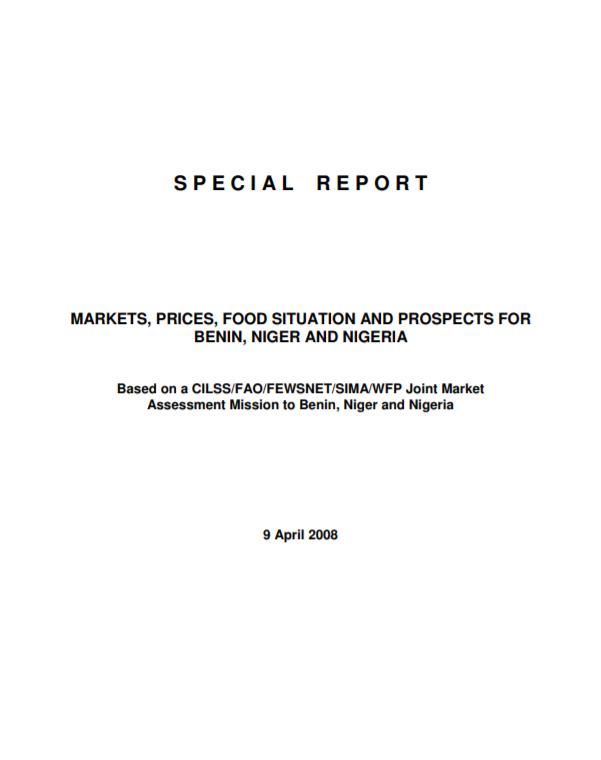
Special Report - Markets, Prices, Food Situation and Prospects for Benin, Niger and Nigeria
09/04/2008
A joint CILSS/FAO/FEWSNET/SIMA/WFP Market Assessment Mission visited key cereal markets in Benin, Niger and Nigeria from 13 February- 9 March to assess the current stock and price levels as well as trade flows within and between countries, and analyze the food security implications in more vulnerable countries.
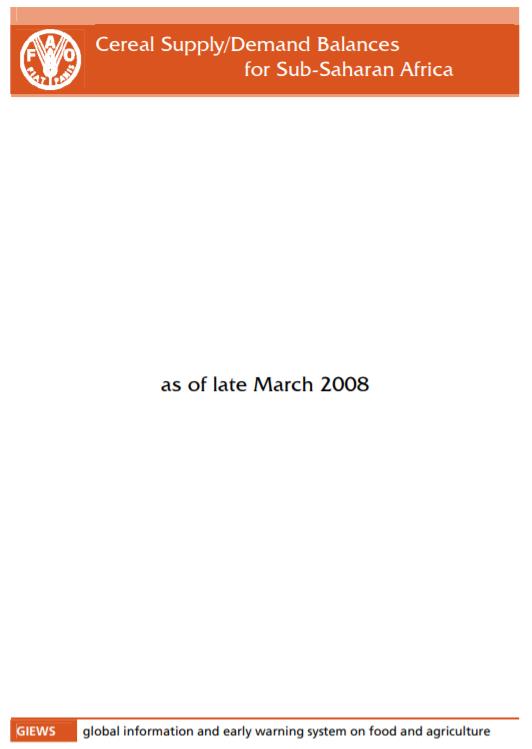
Cereal supply and demand balances for sub-Saharan African countries - No.2, March 2008
31/03/2008
The FAO/GIEWS Country Cereal Balance System (CCBS) is a database of annual supply and utilization balances for main cereals, covering all countries of the world. It has been maintained by FAO/GIEWS since 1980 and is updated on a continual basis. This statistical report, which is a subset of CCBS data, presents the current-year cereal supply and demand balances for all sub-Saharan African countries, highlighting cereal import and food aid requirements of each country. This report is complement ary to the FAO/GIEWS report Crop Prospects and Food Situation and is published four times a year, with the same schedule.
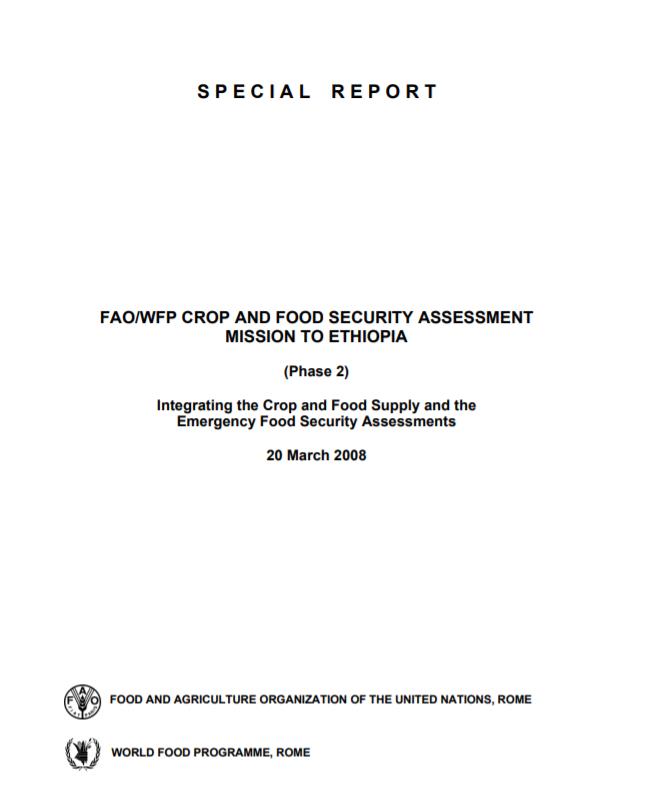
Special Report - FAO/WFP Crop and Food Security Assessment Mission to Ethiopia (Phase 2) - 20 March 2008
20/03/2008
FAO and WFP have carried out an unbroken series of annual CFSAMs in Ethiopia, at the request of the Government, since 19951 . In the early years, the short assessment report, which focused primarily on production of cereals and pulses for the main Meher season, domestic supply/demand conditions and food aid needs, usually came out before the end of December of the assessment year. This was also the case in 2002, given the urgency of providing basic information during a year of crisis. In recent years, most of the CFSAM reports for Ethiopia have been issued well into January, or even in early February, i.e. at least 6 weeks after the conclusion of the in-country fieldwork and preliminary debriefings.
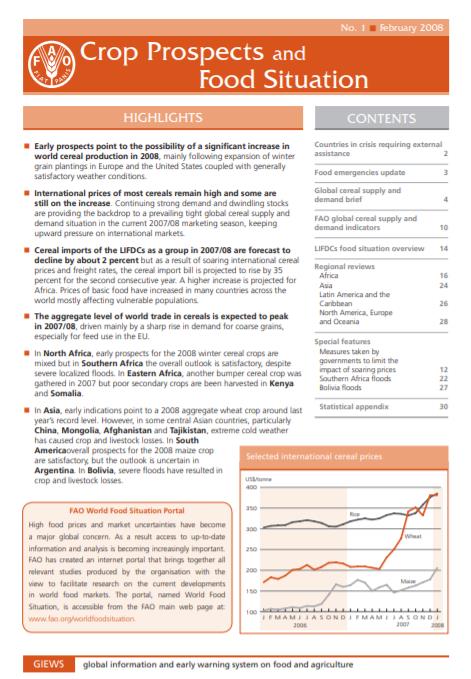
Crop Prospects and Food Situation #1, February 2008
07/02/2008
Early prospects point to the possibility of a significant increase in world cereal production in 2008, mainly following expansion of winter grain plantings in Europe and the United States coupled with generally satisfactory weather conditions. International prices of most cereals remain high and some are still on the increase. Continuing strong demand and dwindling stocks are providing the backdrop to a prevailing tight global cereal supply and demand situation in the current 2007/08 marketing season, keeping upward pressure on international markets. Cereal imports of the LIFDCs as a group in 2007/08 are forecast to decline by about 2 percent but as a result of soaring international cereal prices and freight rates, the cereal import bill is projected to rise by 35 percent for the second consecutive year. A higher increase is projected for Africa. Prices of basic food have increased in many countries across the world mostly affecting vulnerable populations. The aggregate level of world trade in cereals is expected to peak in 2007/08, driven mainly by a sharp rise in demand for coarse grains, especially for feed use in the EU.
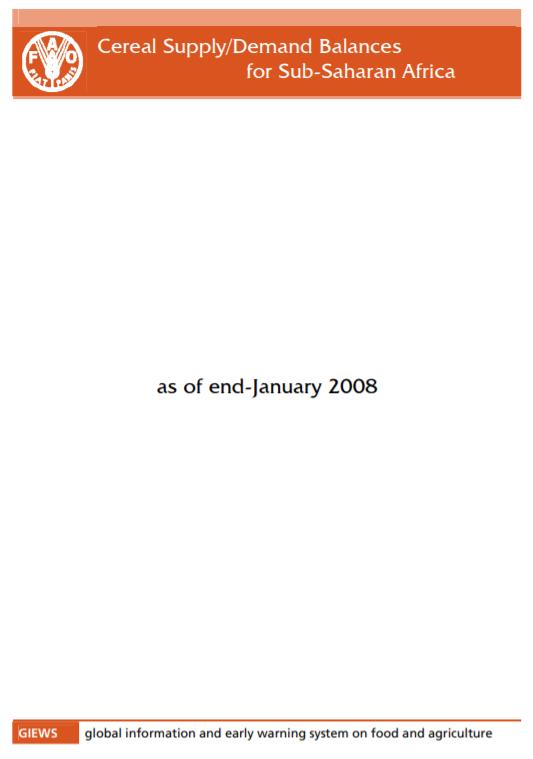
Cereal supply and demand balances for sub-Saharan African countries - No.1, January 2008
31/01/2008
The FAO/GIEWS Country Cereal Balance System (CCBS) is a database of annual supply and utilization balances for main cereals, covering all countries of the world. It has been maintained by FAO/GIEWS since 1980 and is updated on a continual basis. This statistical report, which is a subset of CCBS data, presents the current-year cereal supply and demand balances for all sub-Saharan African countries, highlighting cereal import and food aid requirements of each country. This report is complement ary to the FAO/GIEWS report Crop Prospects and Food Situation and is published four times a year, with the same schedule.
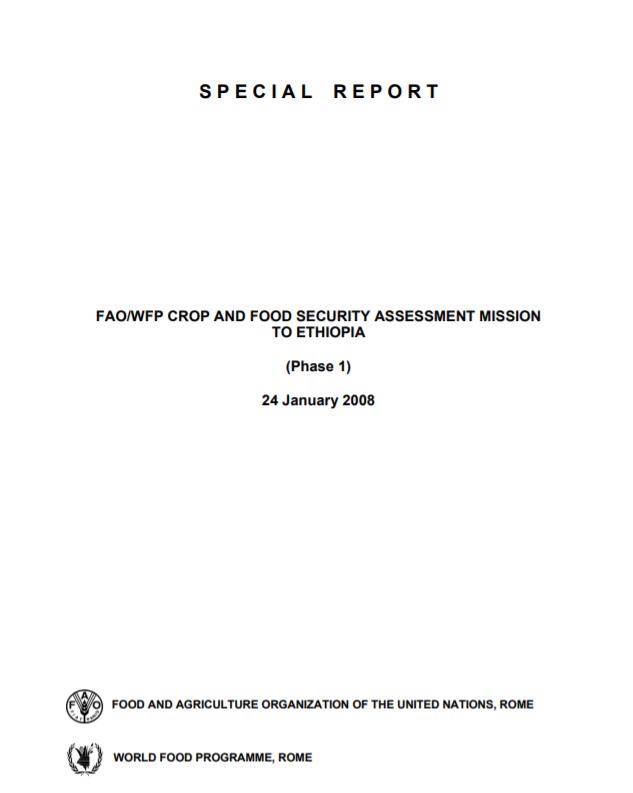
Special Report - FAO/WFP Crop and Food Security Assessment Mission to Ethiopia (Phase 1)
24/01/2008
A Crop and Food Security Assessment Mission visited Ethiopia from 19 November to 12 December 2007 to estimate the 2007 main meher season cereal and pulse production; review the final post-harvest estimates of the 2006 main meher season and 2007 secondary belg season harvests; forecast the 2008 belg season production; and assess the overall food supply situation for the 2008 marketing year (January/December). Accompanied by experts from the Ministry of Agriculture and Rural Development, the Central Statistics Authority (CSA) and by observers from USAID and the European Commission, the Mission mobilised seven teams and visited, over an 18-day period, 63 zones and special woredas (districts) covering all the grain producing regions and the marginal areas. Unlike previous years, the Crop and Food Security Assessment Mission is carried out in three phases - Phase 1: Crop and overall food situation assessment in Nov/Dec (mainly FAO); Phase 2: Meher food security assessment in Nov/Dec (mainly Government/WFP); Phase 3: Synthesis and report writing during early February (joint FAO/WFP).
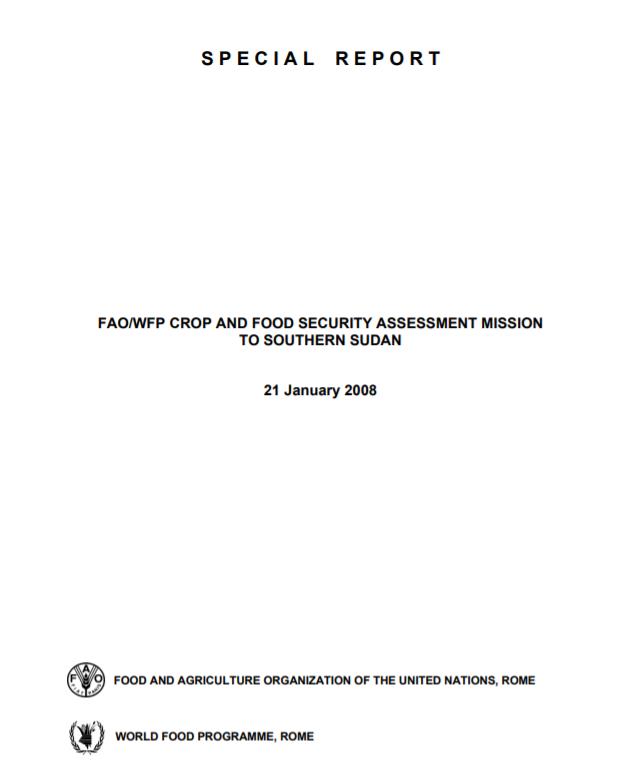
Special Report - FAO/WFP Crop and Food Security Assessment Mission to Southern Sudan - 21 January 2008
21/01/2008
An FAO/WFP CFSAM worked in Southern Sudan from 21 October to 7 November 2007 to estimate cereal production and the food supply situation. Information was obtained from secondary sources, rapid case studies and key informant interviews. In addition, low flying at 300m above ground level, between Mission visiting points for 80 percent of journeys made over Southern Sudan, enabled comprehensive aerial observations by the Mission teams noting the farm, field, crop condition for the duration of the flights.
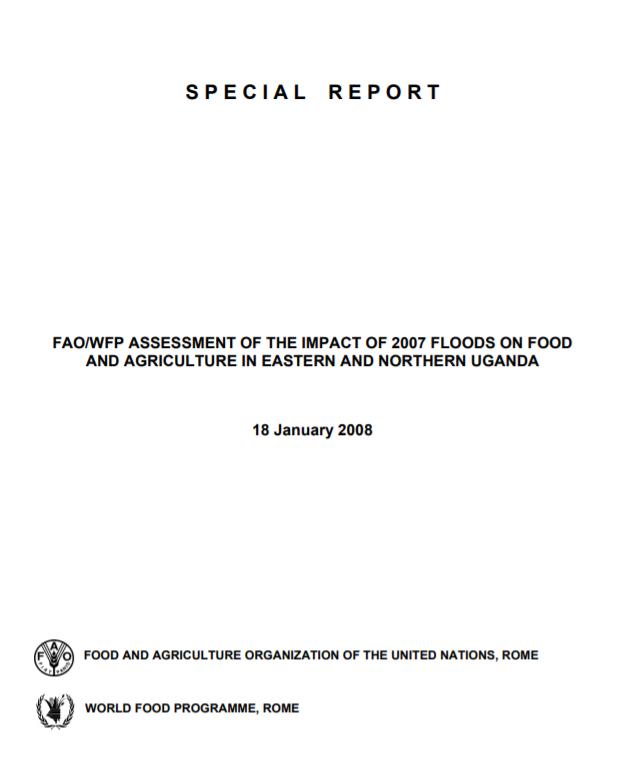
Special Report - FAO/WFP Assessment of te Impact of 2007 Floods on Food and Agriculture in Eastern and Northern Uganda
18/01/2008
Eastern and Northern Uganda experienced heavy rains during the three months of July, August and September 2007 that resulted in severe floods in many locations. At the height of the floods in September, many rivers burst their banks and could not be crossed on foot, some bridges were washed away and roads became impassable. In the worst affected areas some schools, health centres, homes and other infrastructures were destroyed or badly damaged and many families were displaced and forced to seek shelter in school buildings on higher ground. Emergency responses by the Uganda Government and humanitarian agencies included provision of temporary shelter, food, drinkable water, sanitation facilities, medicines, and even helicopters and boats to assist those stranded. As the floods began to subside and movement improved, however, it was felt by the Government and its development partners that there was an urgent need to ascertain the extent of flood damage to the food and agriculture sector. For this reason, the Government requested the Food and Agriculture Organization of the UN (FAO) and the UN World Food Programme (WFP) in late September to assist in carrying out an assessment of the impact of the floods on food production and household food security in the affected areas. The target areas were to be Eastern and Northern Regions.
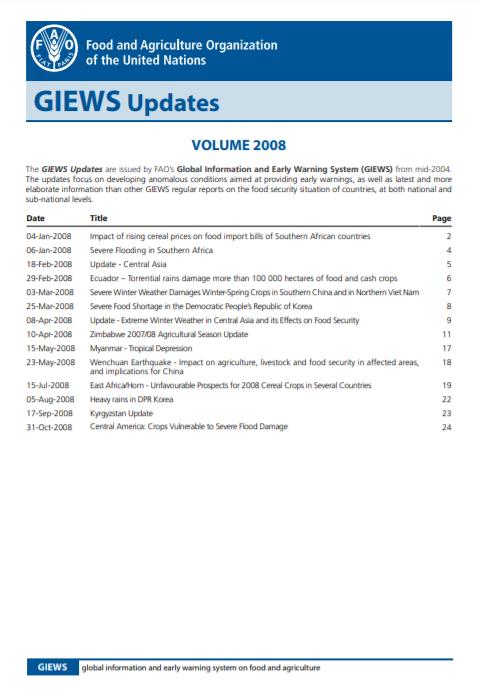
GIEWS Updates - Volume 2008
04/01/2008
The GIEWS Updates are issued by FAO’s Global Information and Early Warning System (GIEWS) from mid-2004. The updates focus on developing anomalous conditions aimed at providing early warnings, as well as latest and more elaborate information than other GIEWS regular reports on the food security situation of countries, at both national and sub-national levels.
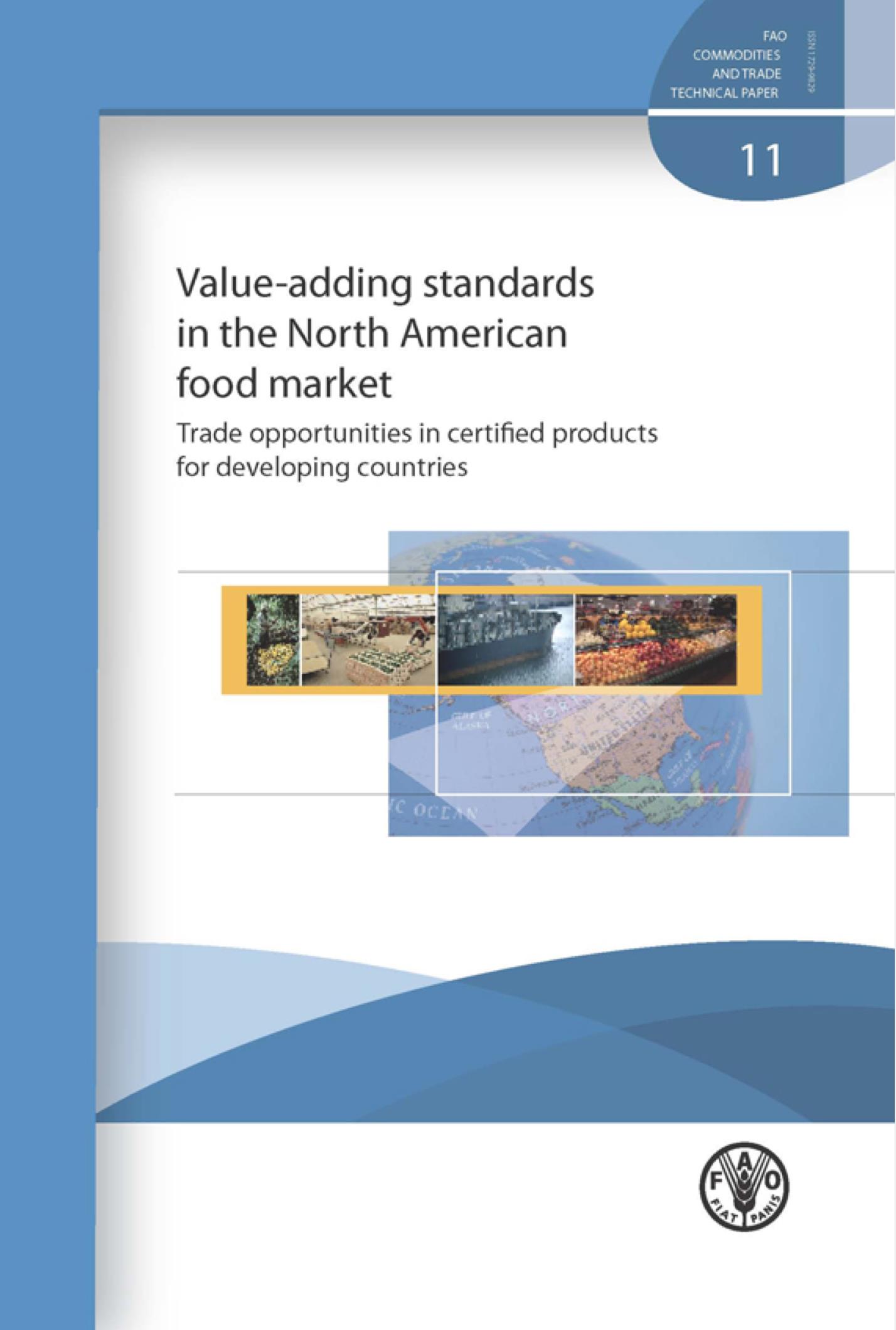
Value-adding standards in the North American food market - Trade opportunities in certified products for developing countries
01/01/2008
This publication analyses the use of voluntary standards and certication schemes in the food markets of the United States of America and Canada. With its large population and its high individual purchasing power, North America provides considerable opportunities for exports of value-added agricultural products. Consumers are increasingly attentive to the social and environmental aspects of food production as evidenced by the signicant expansion of certied food sales in both natural food stores a nd mainstream supermarket chains. North America ranks just behind Europe, the worlds leading region in terms of certied food sales. The United States of America is the worlds largest organic food market and accounts for over 40 percent of global sales. The report assesses the market opportunities for developing countries aiming to export value-added certied foods to North America. After discussing the potential of various types of voluntary standards for adding value to agricultural produc ts, it focuses on a few environmental and social certication schemes that use a registered on-product label targeting consumers. Special emphasis is put on organic and fair trade certied agricultural products due to their value-adding potential, their level of recognition by consumers and the strong and sustained growth of demand. The main product categories examined are tropical fruits, coee and cocoa owing to their economic signicance to many developing countries and their high market potentia l in North America.
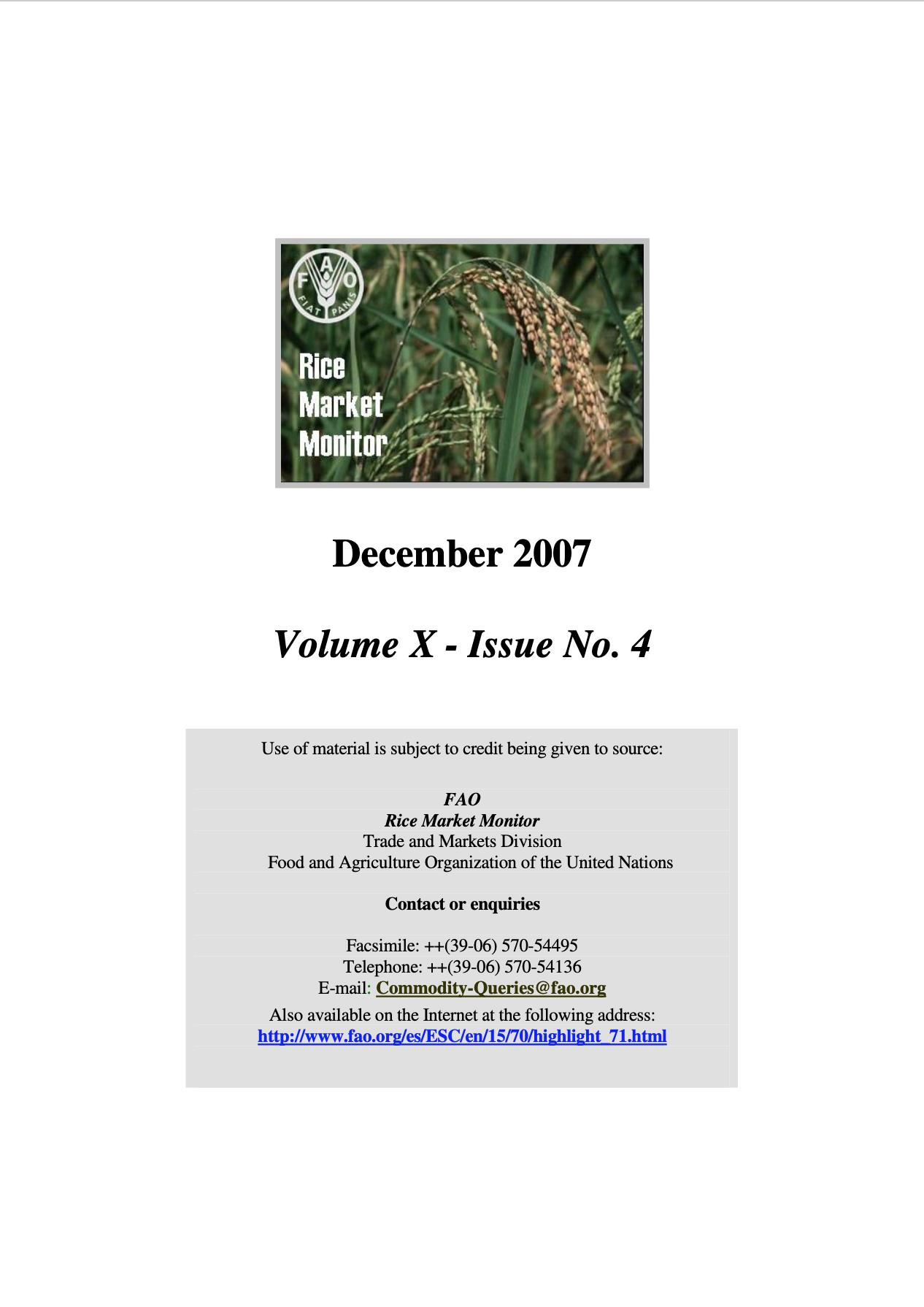
Rice Market Monitor - December 2007
11/12/2007
With the bulk of the 2007 season paddy crops already harvested, the FAO forecast of world paddy production in 2007 has been lifted by 2 million tonnes to 645 million tonnes (430 million tonnes in milled rice eq.), which represents a modest increase of 4 million tonnes, or 0.6 percent, from 2006. Virtually all of the year-to-year world expansion is expected to arise in Asia, while contractions are anticipated in Africa, Latin America and the Caribbean and Oceania, where crops have been co nstrained by adverse weather often associated with “La Niña” conditions. Production in Asia is now foreseen to expand by about 5 million tonnes to 585 million tonnes, spearheaded by large absolute gains in China, India, Indonesia and Myanmar, but also in the Islamic Republic of Iran, Japan, Malaysia, Nepal, the Philippines and Thailand. By contrast, Bangladesh, Cambodia, DPR of Korea, the Rep. of Korea, Sri Lanka and Turkey are forecast to face a decline. Exceptionally wet conditions pre vailed in large parts of Africa, hindering crops in most locations and causing production in the region to fall to an expected 21.6 million tonnes, slightly below the good 2006 performance. Much of the decline is foreseen to concentrate in Egypt, but also in Cote d’Ivoire, Guinea Bissau, Mali and Nigeria. By contrast, Benin, Chad, Guinea, Madagascar, Mozambique, Senegal and Tanzania are set to harvest larger crops.
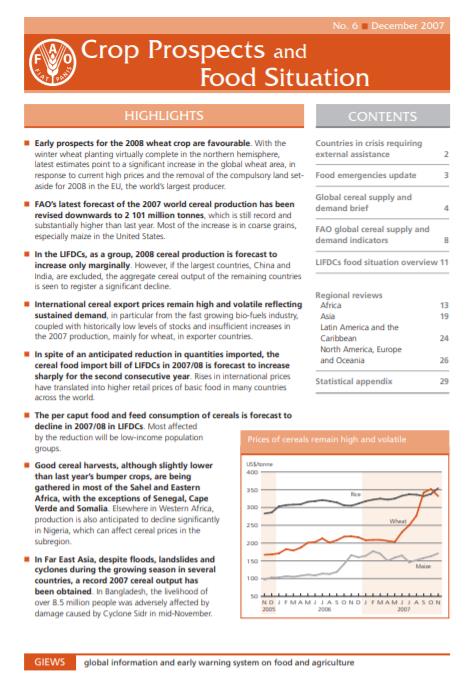
Crop Prospects and Food Situation #6, December 2007
06/12/2007
Early prospects for the 2008 wheat crop are favourable. With the winter wheat planting virtually complete in the northern hemisphere, latest estimates point to a significant increase in the global wheat area, in response to current high prices and the removal of the compulsory land setaside for 2008 in the EU, the world’s largest producer. FAO’s latest forecast of the 2007 world cereal production has been revised downwards to 2 101 million tonnes, which is still record and substantially higher than last year. Most of the increase is in coarse grains, especially maize in the United States. In the LIFDCs, as a group, 2008 cereal production is forecast to increase only marginally. However, if the largest countries, China and India, are excluded, the aggregate cereal output of the remaining countries is seen to register a significant decline.
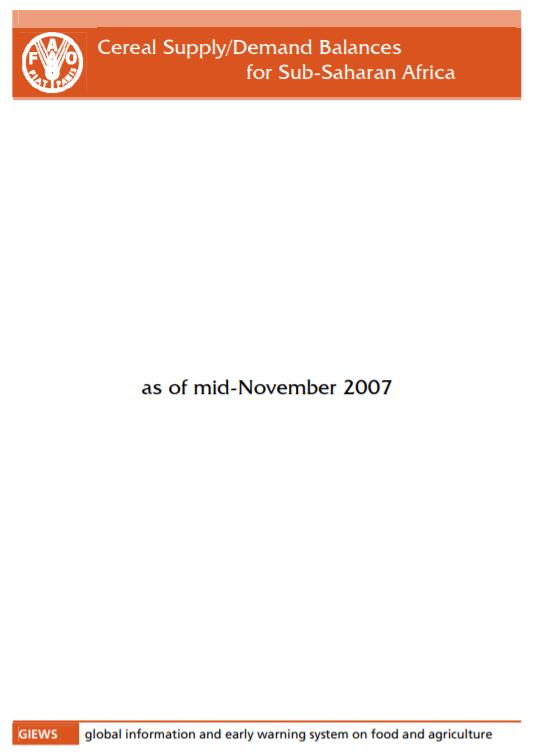
Cereal supply and demand balances for sub-Saharan African countries - No.4, November 2007
22/11/2007
The FAO/GIEWS Country Cereal Balance System (CCBS) is a database of annual supply and utilization balances for main cereals, covering all countries of the world. It has been maintained by FAO/GIEWS since 1980 and is updated on a continual basis. This statistical report, which is a subset of CCBS data, presents the current-year cereal supply and demand balances for all sub-Saharan African countries, highlighting cereal import and food aid requirements of each country. This report is complement ary to the FAO/GIEWS report Crop Prospects and Food Situation and is published four times a year, with the same schedule.
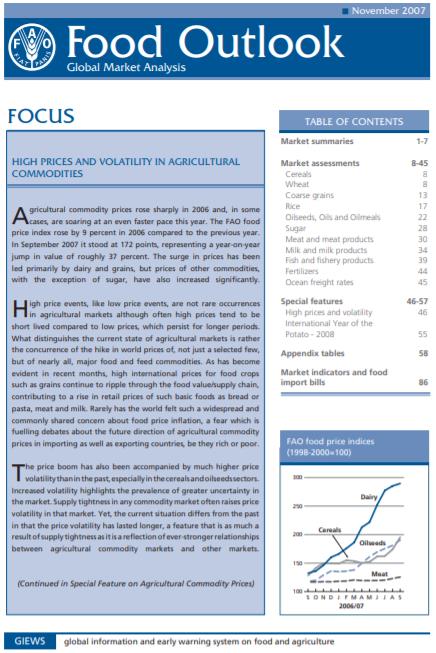
Food Outlook - November 2007
05/11/2007
Agricultural commodity prices rose sharply in 2006 and, in some cases, are soaring at an even faster pace this year. The FAO food price index rose by 9 percent in 2006 compared to the previous year. In September 2007 it stood at 172 points, representing a year-on-year jump in value of roughly 37 percent. The surge in prices has been led primarily by dairy and grains, but prices of other commodities, with the exception of sugar, have also increased significantly.
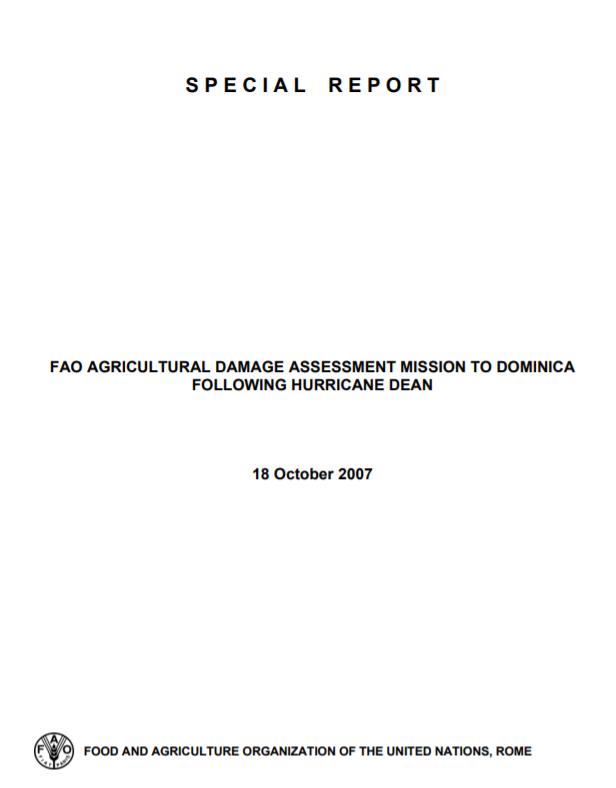
Special Report - FAO Agricultural Damage Assessment Mission to Dominica Following Hurricane Dean
18/10/2007
In response to a request by the Minister of Agriculture of the Commonwealth of Dominica, an FAO Assessment Mission visited the country from 3 to 20 September 2007 to assess damage and losses to the agricultural sector caused by the passage of Hurricane Dean on 16-17 August 2007. The Mission was also requested to propose immediate and medium-term rehabilitation measures aiming to the recovery of the productive capacity of the agricultural sector and livelihood of the affected populations.
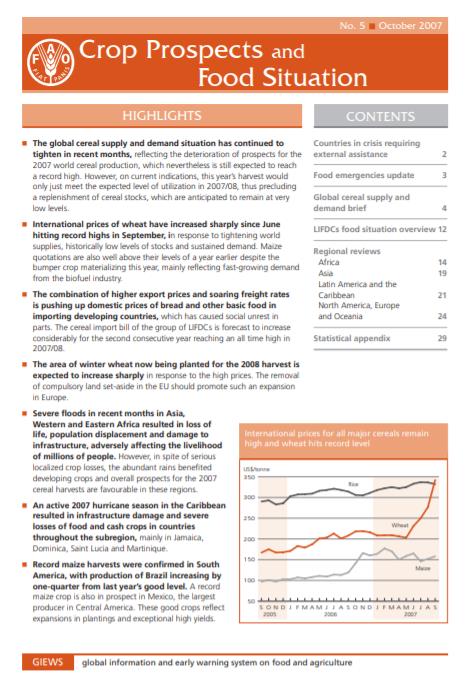
Crop Prospects and Food Situation - #5, October 2007
11/10/2007
The global cereal supply and demand situation has continued to tighten in recent months, reflecting the deterioration of prospects for the 2007 world cereal production, which nevertheless is still expected to reach a record high. However, on current indications, this year’s harvest would only just meet the expected level of utilization in 2007/08, thus precluding a replenishment of cereal stocks, which are anticipated to remain at very low levels. International prices of wheat have increased sharply since June hitting record highs in September, in response to tightening world supplies, historically low levels of stocks and sustained demand. Maize quotations are also well above their levels of a year earlier despite the bumper crop materializing this year, mainly reflecting fast-growing demand from the biofuel industry.
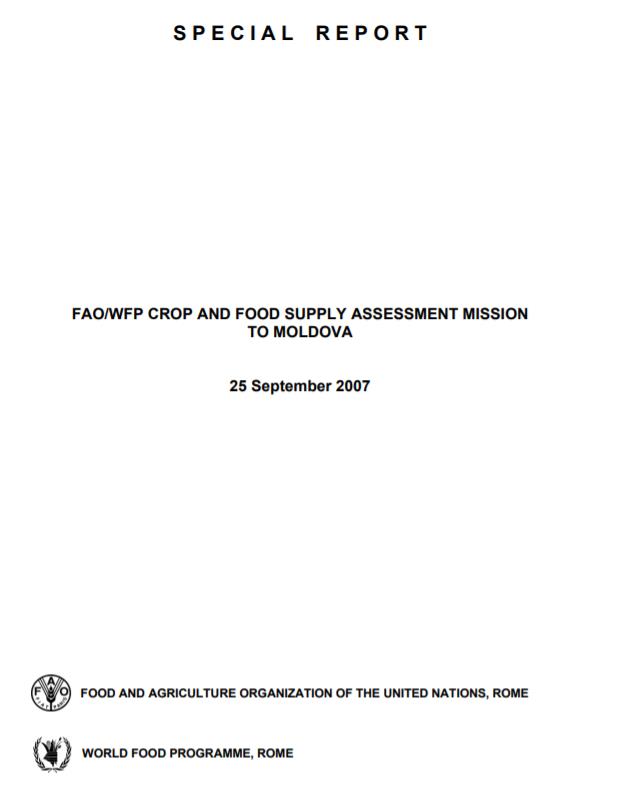
Special Report - FAO/WFP Crop and Food Supply Assessment Mission to Moldova
25/09/2007
In response to a request by the president of the Republic of Moldova to the UN Secretary-General and to the Director-General of FAO, an FAO/WFP Crop and Food Supply Assessment Mission (CFSAM) visited Moldova between 13 and 22 August 2007. The Mission was requested to assess the impact of the drought on the agricultural and livestock sectors as well as the population at large. In addition, the Mission was tasked to devise immediate and medium-term rehabilitation measures to mitigate the impact of drought. Officials from the Ministry of Agriculture and Food Industries (MAFI) accompanied the Mission and a representative from the European Union (EU) participated as an observer.
